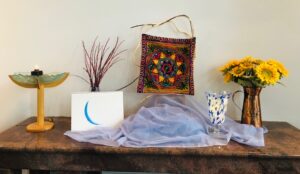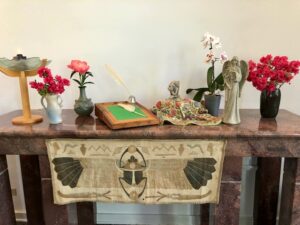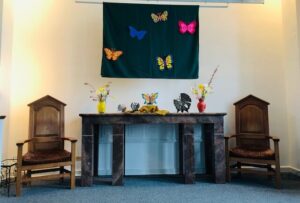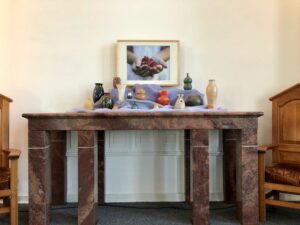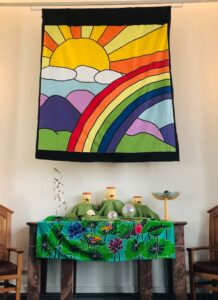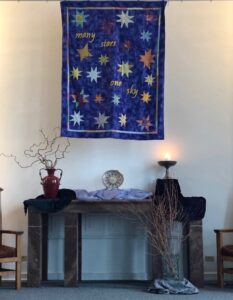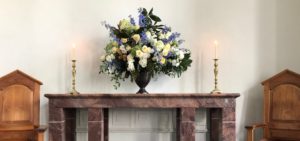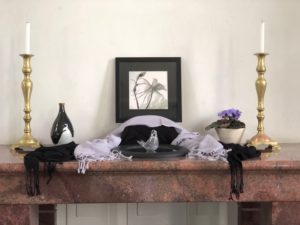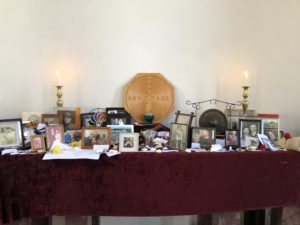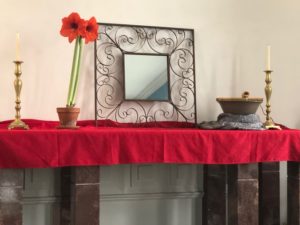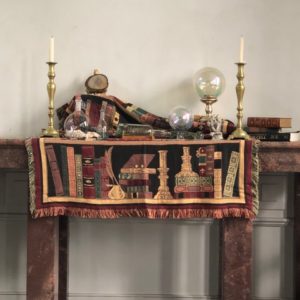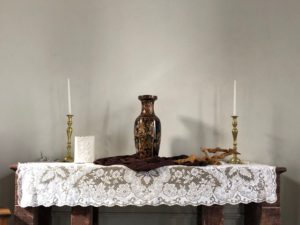Rev. Tim Temerson and Greg Townsend
All are welcome!
If you would like to have a joy or sorrow shared aloud in this week’s community worship service, please complete this form by 9AM Sunday morning.
CLICK HERE for our covid safety protocols.LINK TO ZOOM SERVICE
ORDER OF SERVICE
“Courage starts with showing up and letting ourselves be seen.” Brené Brown
Prelude Offered by Scott Deveaux
Welcome Greg Townsend and Breck Gastinger, UUCville Board of Trustees
Call to Worship Words by David Breeden
Hymn Hold Everybody Up, by Melanie DeMore offered by Scott Deveaux and Matt Hartung
Chalice Lighting
Sharing the Flame
Hymn “As We Leave This Friendly Place”
Centering and Sharing
Offertory Offered by Scott Deveaux
Reading “If There is To Be Peace”
Sermon “The Courage of Peace and Justice” Rev. Tim Temerson
Closing Hymn This is My Song #159 Lyrics by Lloyd Stone
Benediction and Chalice Extinguishing
Postlude, Offered by Scott Deveaux
The text of the sermon given by Reverend Tim.
Good morning again and thanks to Greg for his help with today’s service and with the reading we just shared. I love those words from the Taoist teacher and poet, Lao-Tzu. They point so eloquently and powerfully to how deeply interconnected peace is at every level of our lives – from the individual human heart to peace among nations and peace between humankind and this planet that is our home.
Before I share a few thoughts about peace and courage, let me reiterate how much I am looking forward to next Sunday, when we celebrate Rev. Leia’s 30 years of leadership, service, and ministry to the UU Congregation of Charlottesville. Although I’ve only been working with Leia for a few short months, I have been so impressed and inspired by her brilliance, her creativity, her passion for this congregation and Unitarian Universalism, and by her kindness and compassion. I know I’m preaching to the choir but I do hope many of you will take a few minutes later today or tomorrow to record a brief video or send me an email with your thoughts, stories, and appreciations about Rev. Leia. Next Sunday’s service will celebrate her wonderful ministry and will be followed by a lovely reception.
Whenever I reflect on peace, the first thing that comes to mind is just how little of it there is in our lives, communities, our country, and in the world. How I wish I could begin by telling you I’m feeling hopeful or optimistic about the prospects for peace in the world. But this week has seen another terrible shooting, this time in Raleigh, North Carolina. Two courtroom verdicts reminded us of the horrific school shootings that took place at Sandy Hook Elementary School in Newtown, Connecticut and at the high school in Parkland, Florida. I must say that I have offered thoughts and prayers so many Sundays after one of these shootings that words simply don’t seem to matter anymore.
But as bad as this litany of violence is, we cannot and must not give into despair and resignation. So often after one of these mass shootings, we hear how impossible it is to find anything resembling a solution or that the only answer is more guns and more violence. I, for one, refuse to accept the idea that there is nothing we can do or that our only option is to “fight fire with fire.”
And the place where I think we can begin to find hope and courage is right here, in communities like the UU Congregation of Charlottesville. For all of its challenges and growing edges, religious communities can provide a place to recommit ourselves to the journey towards peace and justice. And I would like to make that beginning today by echoing the words of our reading a few minutes ago that there cannot be peace in our families, our neighborhoods, our cities, or in the nations unless there is peace in our hearts.
And that connection between inner and outer peace, between a peaceful heart and a peaceful world, always reminds me of a story from the Christian gospels that I’d like to share.
One day while crossing a body of water in a boat, Jesus and his disciples encounter a powerful storm. Their boat is tossed about violently and fear and panic grip the disciples. Meanwhile, Jesus is in the back of the boat, fast asleep. When the disciples are certain that the boat is going to capsize, they wake Jesus up, plead for his help, and ask if he does not care that they are all about to die?
According to the story, Jesus calms the raging storm with these three words, “Peace, Be Still.” After the wind ceases and the waters calm, Jesus turns to his disciples and questions why they are afraid and why they have so little faith.
I must say that there is something about this story that really speaks to me right now, especially in these violent and uncertain times. Many days it feels as if I am one of those disciples, fearful and anxious. And I think what speaks to me about this story is not a superhuman or supernatural miracle in which Jesus has control over the laws of nature, but instead the power and simplicity of those three words, “Peace, Be Still, Peace, Be Still.” When I read or say them out loud and simply take time to breathe, my fear and anxiety begin to diminish and the storm that so often plagues my heart and my spirit begins to calm.
We have no way of knowing what really happened that day or if Jesus and his disciples actually got caught in that storm. The whole story could very well be just that – a story. But if they did encounter a storm that made the disciples fearful, I’m guessing that the miracle in that moment wasn’t Jesus rewriting the laws of nature, but rather his calming the storm in their hearts and minds. In that moment, Jesus calmed the disciples with his peaceful presence and his calming words, urging them to be still, to breathe, and to see that there is an alternative to fear.
And I think those three simple words offer us the beginning of a path towards a world of peace and justice. I know it may sound simplistic but I believe that if we can simply begin to breathe, to be still, and to experience inner peace – we can calm the storms and the fears in our own hearts. And as Jesus demonstrated that day in the boat, the calm and stillness in one heart radiates outward and has the power to calm the storms raging in our hearts and all around us.
But how exactly does that work? How can peace in one heart lead to peace and justice in the world?
The answer, I think, can be found in an observation made by spiritual teachers and mystics from all the world’s religious traditions. As we begin to discover and develop places of peace within ourselves, that inner peace begins to transform how we perceive and interact with others. Rather than seeing the other as a threat or as the enemy, a peaceful heart enables us to begin to see them as a fellow human being – flawed and broken, fearful and suspicious – just as we are. And the moment we can begin to see another as we see ourselves, the seeds of genuine peace have been planted.
Thich Nhat Hanh, the Buddhist priest and teacher who passed away earlier this year, has written and spoken very powerfully about the connections between inner peace and our deep connection to others, which he calls inter-being. He says that when we experience a sense of inner peace and shared presence, we become deeply aware of the unity and oneness at the heart of existence. And, in those moments, we cannot help but see a sibling rather than an enemy, including those with whom we may differ or share little in common.
I want to leave you this morning with one more story about inner peace – a story that shows just what a powerful and transformative force it can be. The story takes place in Nashville, Tennessee in the winter and spring of 1960. It begins with the determination of a group of mostly African-American college students to end segregation at restaurants and lunch counters in the city of Nashville. The students chose to use nonviolent methods, in this case sit-ins, to raise awareness about the injustice of segregation and to pressure city leaders to change the unjust and discriminatory laws.
Prior to launching the nonviolent campaign, the students were trained in nonviolence by an extraordinary minister named James Lawson. Lawson had studied Gandhi’s methods in India and was one of first people to introduce those methods to another young minister at the time, Dr. Martin Luther King Jr. Here is an image of Lawson leading one of those workshops in Nashville
During the training sessions, Lawson and the students prayed, meditated, and sang together. They engaged in what the civil rights movement came to call “a process of self-purification,” meaning they cultivated deep-seated peace and compassion in their hearts. And they also role-played interacting with their “enemies.” Lawson taught the students to never lose sight of the humanity of their oppressor, even in the midst of the most violent behavior. He also taught them to try and make eye contact with their adversaries so that each individual could see into the heart of another. As Lawson famously taught them, if they followed the path of an eye to an eye rather than an eye for an eye, the students could transform hatred and violence into justice and peace.
The sit-ins began in February of 1960 and from the outset, they were marked by courageous nonviolence on the part of the students and hateful violence on the part of the citizens of Nashville and the Nashville Police.
Throughout the campaign, one of the most important student leaders was Diane Nash. That’s Diane Nash sitting at the lunch counter wearing glasses. From the beginning of the campaign, Nash demonstrated extraordinary skill and wisdom. She possessed an uncanny ability to remain calm and centered in the face of the most vicious insults and violent attacks. She was also able, as Lawson had taught, to find some shred of humanity in the midst of the most inhumane behavior. Without question, Diane Nash embodied the power and the blessings of a peaceful and nonviolent heart.
After two months of courageous sit-ins, attacks by angry mobs, and mass arrests by the police, tensions reached a boiling point when the home of a prominent black attorney who had defended the protesters in court was bombed. The following day, student activists marched to City Hall to confront Nashville’s segregationist mayor, Ben West. A few weeks earlier West had ordered Nashville’s police to stand aside so that angry mobs could beat students and then had ordered police to arrest the students rather than those participating in mob violence.
When the students reached City Hall, Mayor West met them on the steps. At first, he responded angrily and defensively, blaming the students for increasing tensions and provoking violence, including the bombing of the attorney’s home.
It was at this moment that Diane Nash stepped forward to confront the mayor. Rather than shouting at him or even blaming him for the violence he had ordered and condoned, Nash looked the mayor right in the eye and asked him in a calm, courageous, and resolute voice if he felt it was right to discriminate against human beings on the basis of race or skin color. Mayor West, who was expecting anger and insults, was caught off guard by this reasoned appeal to his humanity. The mayor hesitated and responded that, in theory, he didn’t support discrimination. But Diane Nash wouldn’t settle for platitudes or empty words. She persisted and pressed the mayor to follow the logic of his statement. “Then Mr. Mayor, are you recommending that the lunch counters be desegregated?” Confronted again by this determined appeal to fairness and human dignity, Mayor West paused, thought for a moment, and then simply answered “Well, Yes I do.” The students erupted in applause and, in a relatively short period of time, Nashville’s lunch counters were desegregated.
When he was interviewed sometime after his encounter with Diane Nash, West tried to explain his extraordinary change of heart. “I found that I had to answer her question frankly and honestly – that I didn’t agree that it was morally right to refuse them service. I received considerable criticism, but if I had to answer that question again, I would answer it in the same way because it was a moral question and it was one I had to answer as a man and not as a politician.”
And that, friends, is the transformative power of peace and nonviolence – a power that can, as Dr. King used to say, make a way out of no way. Rather than following the path Mayor West had chosen over the preceding days and weeks – a path of violence and intimidation – Diane Nash and her fellow students let the peace in their hearts and the courage of their convictions guide them. They boldly and courageously challenged an unjust status quo and put their lives on the line. But, in doing so, they never resorted to the cruelty, the violence, and the hatred of their oppressors. Instead, they followed the path of peace – a path that enabled them to change the world by resisting oppression, stirring the conscience, and touching the humanity of their oppressors.
Diane Nash didn’t stop with Nashville’s lunch counters. She was a leader and active participant in the Freedom Rides. She took part in countless sit-ins across the south, helped found the Student Nonviolent Coordinating Committee (SNCC), and was a key organizer and strategist in the Alabama Voting Rights campaign that eventually resulted in the passage of the Voting Act of 1965.
For all of her extraordinary contributions to justice, democracy, and nonviolence, I’m guessing many of you have never heard of Diane Nash. I learned about her incredible courage and brilliance from reading a wonderful book which I highly recommend called The Children by the late writer, David Halberstam. But like so many women, and especially women of color, Diane Nash’s contributions have generally been ignored and minimized. Although it came many years later than it should have, I am happy to say that just a few weeks ago, Diane Nash was awarded the Presidential Medal of Freedom.
As President Biden remarked when awarding the medal to Diane Nash. “Her activism echoes the call of freedom around the world today. And yet she is the first to say the medal is shared with hundreds of thousands of patriotic Americans who sacrificed so much for the cause of liberty and justice for all. And by the way, she asked me to make sure to add that because she didn’t want to take all the credit herself.”
It is the courage, the activism, and the accomplishments of people like Diane Nash that gives me hope. Cultivating peace in our hearts is the way to peace in our communities and in our world. We will never make our lives or this world safe by turning our homes, our schools, our churches, and our world into arsenals of fear and hate. Rather, we must have the courage to do the hard work of peace and justice, work that makes it possible to transform both hateful hearts and unjust systems of oppression. I know that may sound idealistic in a world that is so badly broken. But as James Lawson, Diane Nash, and all the courageous students in Nashville proved in 1960, peace is stronger than vengeance and nonviolence can, in Dr. King’s famous words, “tear down gigantic mountains of evil.”
So I’m going to do my best to follow the path of peace – the path of Gandhi and King, of James Lawson and Diane Nash. And that path begins right here, in my heart and in my life and in your hearts and in your lives. So my invitation to all of us today is to let peace and nonviolence be our guide. Let peace begin with prayer and meditation, with quiet and with stillness. Let peace begin as our hearts open to the dignity and the humanity of others, including those with whom we may differ and disagree. And let peace and justice begin with our courage and determination to move beyond these walls so that we may be instruments of peace and justice in the world.
I don’t know if committing ourselves to cultivating peace in our hearts and to being instruments of peace in the world will go very far in healing all the brokenness. But I do know that if we choose to sit behind a wall of fear and indifference, things will never change. So let us now rise in body or spirit to sing “This is My Song,” and let that beautiful song be our call and our commitment to build a world of peace – a peace that begins with you and with me.

